
Stiles Oliver Clements was an architect practicing in Los Angeles and Southern California.

The Eastern Columbia Building, also known as the Eastern Columbia Lofts, is a thirteen story Art Deco building designed by Claud Beelman located at 849 S. Broadway in the Broadway Theater District of Downtown Los Angeles. It opened on September 12, 1930 after just nine months of construction. It was built at a cost of $1.25 million as the new headquarters and 39th store for the Eastern Outfitting Company and the Columbia Outfitting Company, furniture and clothing stores founded by Adolph Sieroty and family. At the time of construction, the City of Los Angeles enforced a height limit of 150 feet, however the decorative clock tower was granted an exemption, allowing the clock a total height of 264 feet.

Barnsdall Art Park is a city park located in the East Hollywood district of Los Angeles, California. Parking and arts buildings access is from Hollywood Boulevard on the park's north side. The park is a Los Angeles Historic-Cultural Monument, and a facility of the City of Los Angeles Department of Cultural Affairs.
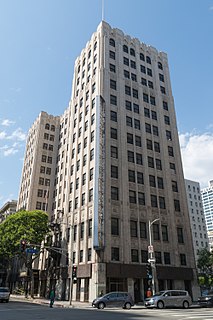
The Garfield Building is a thirteen-story Art Deco style historic structure in Los Angeles, California. Designed by American architect Claud Beelman, construction lasted from 1928-30. It is listed on the National Register of Historic Places.

The Bob Baker Marionette Theater, founded by Bob Baker and Alton Wood in 1963, is the oldest children's theater company in Los Angeles. In June 2009, the theater was designated as a Los Angeles Historic-Cultural Monument.

Santa Susana Pass State Historic Park is a California State Park of approximately 680 acres (2.8 km2) located on the boundary between Ventura and Los Angeles counties, between the communities of Chatsworth and Simi Valley. Geologically, the park is located where the Simi Hills meet the Santa Susana Mountains. Here in the western part of the Transverse Ranges, the land is dominated by high, narrow ridges and deep canyons covered with an abundant variety of plant life. The park offers panoramic views of the rugged natural landscape as a striking contrast to the developed communities nearby. The park is also rich in archaeological, historical and cultural significance.

The former First Church of Christ, Scientist, built in 1912, is an historic Christian Science church edifice located at 1366 South Alvarado Street in Pico-Union, Los Angeles, California.
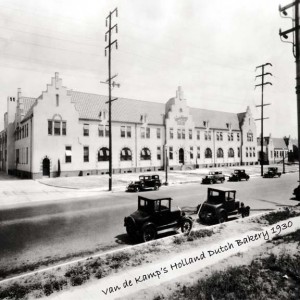
The Van de Kamp Bakery Building was built in 1930 in the Glassell Park neighborhood of Los Angeles. It served as the headquarters of the chain of bakeries and coffee shops known for their distinctive windmill architecture. The building was designed by New York architect J. Edwin Hopkins to resemble a Dutch 16th century farmhouse. Originally there was a Van de Kamp's store next to the building, which was one of the first Van de Kamp's stores ever made and had the famous Van de Kamp's windmill style design. The building remains the only example of an industrial plant in the Dutch Renaissance Revival style. The bakery closed in October 1990 after Van de Kamps filed for Chapter 11. The building is a designated Los Angeles Historic-Cultural Monument, declared on May 12, 1992.

Old St. Peter's Episcopal Church is a Los Angeles Historic-Cultural Monument located in the San Pedro section of Los Angeles, California, near the Port of Los Angeles. Built in 1883 in the Carpenter Gothic Victorian architecture style, it is San Pedro's oldest church.

The James H. Dodson Residence is a Los Angeles Historic-Cultural Monument located in the San Pedro community of Los Angeles, California, near the Port of Los Angeles.

Harbor View House, formerly the Army and Navy Y.M.C.A., is a Los Angeles Historic-Cultural Monument located in the San Pedro section of Los Angeles, California, near the Port of Los Angeles. It is a five-story Spanish Colonial Revival style structure located on a bluff overlooking the harbor.

Hyde Park Congregational Church is a church in the Hyde Park section of Los Angeles. The original wooden church with two front-corner towers was declared a Los Angeles Historic-Cultural Monument in 1963. Despite the designation, the church was demolished in 1964.

Forthmann House, now known as USC Community House, is a Los Angeles Historic-Cultural Monument located in the North University Park Historic District of West Adams, Los Angeles, California. It is a 4,200-square-foot (390 m2) Victorian house built c.1887, designed by Burgess J. Reeve. It was relocated in 1989 from its original location. A secondary structure known as the Forthmann Carriage House was moved from its original location to its new home in Angelino Heights at 812 E Edgeware Rd.

Samuel Tilden Norton, or S. Tilden Norton as he was known professionally, was a Los Angeles-based architect active in the first decades of the 20th century. During his professional career he was associated with the firm of Norton & Wallis, responsible for the design of many Los Angeles landmarks.

The Ernest and Florence Bent Halstead House is an American Craftsman style home built in 1912 in Los Angeles, California.

The Montecito View House, located at 4115 Berenice Place in Montecito Heights, Los Angeles, is a Craftsman bungalow designed by architect Lester S. Moore and built in 1909. It was one of the very first homes constructed in Montecito Heights, and was featured on the cover of the Mutual Building Company's advertising pamphlet. Interesting aspects of the home include clinker brick and Arroyo stone chimney. The style is reminiscent of the work of Greene and Greene, Pasadena.
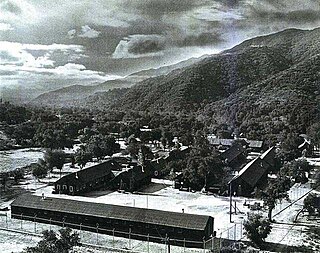
Tuna Canyon Detention Station was a temporary detention facility used for holding enemy aliens who were considered by the U.S. government to be risks to national security. The detention camp was located in Tujunga at a former Civilian Conservation (CCC) Camp, constructed in 1933. The camp was converted into the Tuna Canyon Detention Station just after the bombing of Pearl Harbor. Administered by the Department of Justice, it opened on December 16, 1941, when the first group of detainees arrived from various Southern California towns and cities. Tuna Canyon had a capacity of 300, and until its closing in October 31, 1943, over 2,000 Japanese, German, and Italian immigrants, Japanese Peruvians, and others were imprisoned there. Most were transferred to other DOJ facilities like Fort Missoula, Fort Lincoln and Santa Fe. The site was used as a probation school after the war.
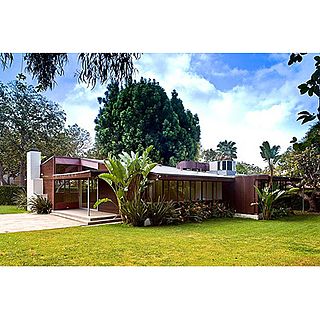
Neutra/Maxwell House, referred to as the Maxwell House, is a Los Angeles Historic-Cultural Monument located in Angelino Heights, Los Angeles, California. It is a 1,200-square-foot (110 m2) Mid-Century modern house built c.1941, designed by Richard Neutra. It was relocated in 2008 from its original location at 475 North Bowling Green Way in Brentwood, Los Angeles thanks to the efforts of Barbara Behm. The Charles and Sylvie Maxwell House was designed and built by Neutra for the two musicians, she a violinist and he a composer, who wanted "acoustically suitable living quarters" on a budget of $6,750. Her practice room is farthest away from the composers study. There is a nice integration of sloping and flat roofs with the introduction of a glass triangle into the redwood siding. It was with this project that Neutra first experimented with the peaked roof and triangular glazed gable openings that later became a trademark of the firm when pitched roofs were mandated by city building codes. Further, this design element profoundly influenced the design of American suburban architecture in the 1950s and 60's.
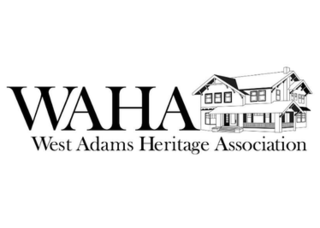
Founded in 1983, the West Adams Heritage Association (WAHA) is an historic preservation organization in Los Angeles, California that is focused on the preservation of the Historic West Adams section of the city.
Chapman Plaza is a building located between West Sixth Street and Alexandria Avenue in Los Angeles, California. The historic plaza building is about 50,000 square feet and is located in the heart of Koreatown, hosting several restaurants, bars, and cafes. The address is 3465 W 6th St, Los Angeles, CA 90020.




















